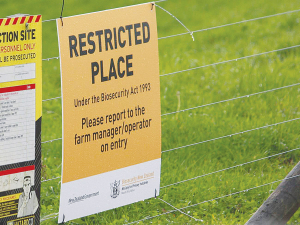We must keep our foot on the pedal
OPINION: Last week marked a major step forward in our work to eradicate Mycoplasma bovis.
 An independent review has confirmed appropriate steps have been taken by the M. bovis Programme to remove infection in Wakanui.
An independent review has confirmed appropriate steps have been taken by the M. bovis Programme to remove infection in Wakanui.
An independent review into Mycoplasma bovis infection in Wakanui, mid-Canterbury, shows appropriate steps are being taken to remove infection in the area, says M. bovis Programme director Simon Andrew.
The review was commissioned by the programme’s partners, MPI, DairyNZ, and Beef + Lamb NZ, in mid-2022 after it became apparent infection was circulating in a small geographical area despite the use of disease control measures, which have proven successful in other areas around New Zealand.
“The review, carried out by independent epidemiologist Dr Jonathan Happold, has endorsed the approach we are taking in the Wakanui area,” Andrew says.
“While the review did not confirm the sources of infection in Wakanui, it notes that the area has been unique to other parts of New Zealand, which have experienced M. bovis infection,” he says.
Andrew says Wakanui had a large, concentrated and dynamic population of infected animals within the local feedlot and there was a small cluster of Confirmed Properties, most of which have paddocks within 1.5km of the feedlot.
Dr Happold concluded the unusually high amount of infection on the Five Star Beef feedlot could have allowed for airborne transmission that is highly unlikely to have occurred in other areas of New Zealand.
“The review has not determined the transmission routes occurring in Wakanui with any certainty, and it is possible we may never be able to categorically says what the transmission route is,” Andrew says.
“What we do know is, eradication is not dependent on knowing the transmission route. What is important is that we remove the infection from the area which is exactly what we’re doing.”
As part of the review, Happold also looked at a range of transmission routes, including mechanical vectors like birds and flies, manure, effluent, and groundwater. The review concluded infection is unlikely to have occurred via these routes.
“Dr Happold supports the depopulation plan for Five Star Beef and the use of a Controlled Area Notice (CAN). He made several recommendations and most of these have already been implemented,” Andrew says.
Andrew says the eradication effort continues to make good progress, with the high-risk area of the CAN now free of cattle and the CAN set to be lifted in mid-March.
“It is expected all current Confirmed Properties are likely to be cleared within the first half of the year,” he says.
“While the job is far from over, we are as close to moving to the next phase of the eradication as we have ever been and the collective effort from farmers, industry and Programme staff has helped us get to where we are today."
Last month's Agritechnica event led to a wide group of manufacturers celebrating successes when the 2026 Tractor of the Year Competition winners, selected by a panel of European journalists, were announced in Hanover Germany.
According to the latest Federated Farmers banking survey, farmers are more satisfied with their bank and less under pressure, however, the sector is well short of confidence levels seen last decade.
Farmer confidence has taken a slight dip according to the final Rabobank rural confidence survey for the year.
Former Agriculture Minister and Otaki farmer Nathan Guy has been appointed New Zealand’s Special Agricultural Trade Envoy (SATE).
Alliance Group has commissioned a new heat pump system at its Mataura processing plant in Southland.
Fonterra has slashed another 50c off its milk price forecast as global milk flows shows no sign of easing.